 Free Abstract Reasoning Practice Test with Questions, Answers, and Explanations
Free Abstract Reasoning Practice Test with Questions, Answers, and Explanations
Our carefully built free practice test features authentic abstract reasoning questions that mirror leading aptitude assessments. These sample questions have been selected from our comprehensive Abstract Reasoning PrepPack to help you:
- Master pattern recognition techniques
- Develop quick analytical thinking
- Confidently approach your upcoming assessment
Prepare effectively with questions employers use in pre-employment screening and secure your dream position.

Free Abstract Reasoning Practice Questions
Check out our Free Aptitude, Spatial Reasoning, Verbal Reasoning, Numerical Reasoning and Critical Thinking Tests.
Next In Series Questions + Solutions
Sample Question 1:
Choose the image that completes the pattern (From left to right):

Ace Your Job Search with a Custom Prep Kit
Job hunting doesn't have to be stressful.
Prepare smarter and ace your interviews faster with our Premium Membership.



Sample Question 2:
Choose the image that completes the pattern (From left to right):
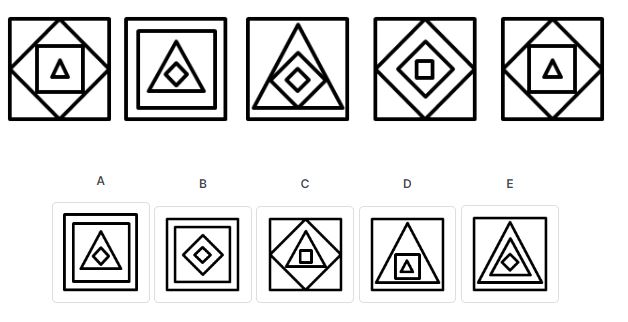
Tip: The main challenge associated with Next In Series questions is the way in which they push the line between objective and subjective interpretations. Test takers are likely to find rules that are based on things they have seen before, and less likely to find rules that are anchored in themes and concepts they are unfamiliar with. To easily locate the sole correct interpretation, it is helpful to familiarise yourself with the type of patterns test publishers like to include.
In Next In Series exercises, there are several images arranged in a row. Your job is to understand the pattern so that you can find the omitted image. This is not always easy, with test-makers often implementing tactics of misdirection, including features that seem relevant to the pattern but are, in fact, arbitrary. The time pressure and cognitive load as you try to come up with and test various theories certainly add to the challenge.
Despite all this, Next In Series questions are a skill that can be acquired like any other. You can improve your logical reasoning by answering more Next in Series questions. Other Abstract Reasoning practice questions are included in ISEB, Saville Assessment, Sova Assessment, Korn Ferry Tests, CCAT, SHL, and Aon cut-e.
Want to Practise Next In Series Questions?
You can use our unique Abstract Reasoning Practice Pack, which features comprehensive prep material for these types of questions.
Next, we will tackle a similar type of question. While Next In Series features a single row (or column) of images with a pattern that runs left-to-right (or top-to-bottom), matrices feature rows AND columns and patterns that run vertically AND diagonally.
Don't panic, though. We will show multiple examples and explain how to ace these questions
Matrices Questions + Solutions
Sample Question 3:

Choose the correct three figures to complete the sequence:
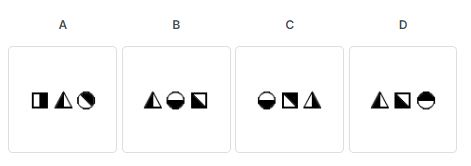
Sample Question 4:
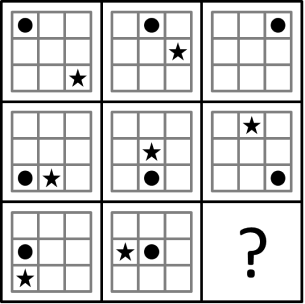
Which of the following boxes should replace the question mark (?) to complete the pattern?
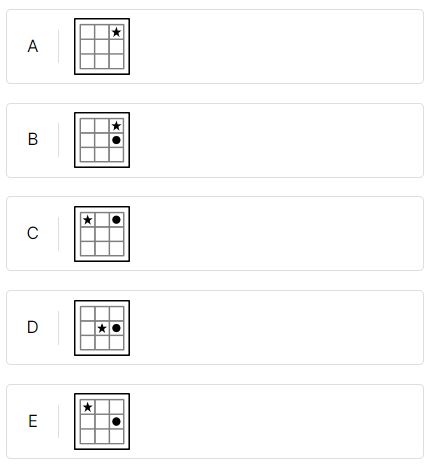
Sample Question 5:
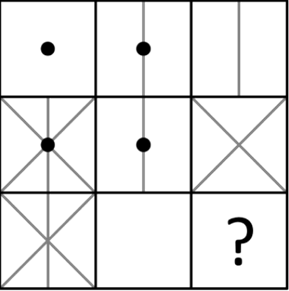
Which of the following boxes should replace the question mark (?) to complete the pattern?

Abstract Reasoning Tests differ in three main ways: There are some tests that require the use of a more significant number of logical rules in order to formulate shapes correctly. There are also tests that use fewer, more complex rules. Finally, some tests give you more time for each question, while others give you less time. Most tests with more than three rules give test takers less than 30 seconds, whereas tests with fewer rules give them up to 45 seconds.
To get the most out of your prep, it is recommended to practice for the specific exam you are being slated to take.
Get started by clicking the name of YOUR abstract reasoning assessment:
| Test Description | |
|
SHL tests typically feature abstract reasoning questions. Read more about the SHL PrepPack |
SHL Practice |
|
The Saville Abstract Reasoning Test is one of a host of pre-employment aptitude tests offered by Saville. You can read more about Saville tests |
Saville Practice |
|
Aon, also known by its previous name 'cut-e', is famous for its innovative approach to testing. Read more about the Aon PrepPack. |
Aon/cut-e Practice |
|
The Alva Labs Logic test uses matrices, as seen on this page, to assess inductive reasoning. You can read more about the Alva Labs test. |
Alva Labs Practice |
|
Highly challenging, this matrix test invokes sharp logical and abstract intuition. Read about the Matrigma test. |
Matrigma Practice |
|
Yet another assessment that focuses on matrices, the Raven test is extremely ubiquitous and is the inspiration for the Talent Q Logical Assessment. Read more about The Raven's Progressive Matrices Test. |
Raven's Practice |
|
The University Clinical Aptitude Test (UCAT) is used to select applicants for medical and dental programmes. As you might expect, it is made to be quite difficult. You can read more about the UCAT. |
UCAT Practice |
|
The A-RAT 3R Abstract Reasoning Test published by Hudson is a unique test that uses its own question format. You can learn more about the Hudson Abstract Reasoning Assessment. |
Hudson Practice |
If your test isn't featured here, you can look for it using the search bar at the top of the page, or simply contact us!
Sample Question 6:
The following test shape belongs to:

Sample Question 7:
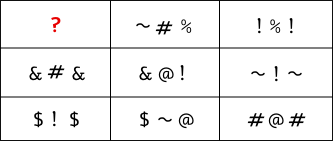
Which of the following boxes should replace the question mark (?) to complete the pattern?
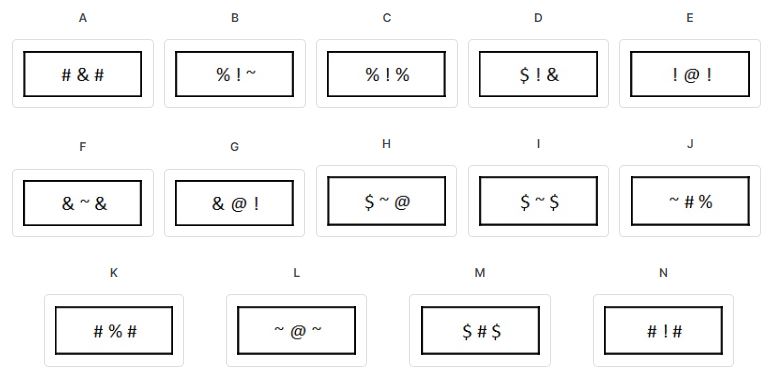
Matrices are generally considered more difficult than Next In Series questions because the pattern isn't necessarily linear. The advantage with matrices, however, is that more images give you more context to try and understand the pattern. All-in-all, matrices are a formidable but surmountable challenge.
Practise Matrix Questions with Our PrepPack
A Matrix is a collection of separate images that follow a specific pattern. It is up to you to figure out which image will appear next by understanding the pattern.
Matrices are one of the most commonly used drills for abstract reasoning, appearing in tests such as the Alva Labs Test, Matrigma Test, and Raven's Progressive Matrices (RPM).
Odd One Out Questions + Solutions
Sample Question 8:
Choose the odd one out:

In contrast to Matrices and Next in Series questions, odd one-out questions require deductive reasoning as well as inductive reasoning. The key is to identify a rule that describes all but one figures, and then determine which shape differs from the others in the series.
Access JobTestPrep’s Abstract Reasoning preparation to practise more odd-one-out exercises. Other Abstract Reasoning practice questions are included in Saville, CCAT, and Aon cut-e.
Pass Your Abstract Reasoning Test
If you are looking to improve your abstract reasoning abilities and test scores, look no further. Our exclusive Abstract Reasoning PrepPack™ includes everything you need to pass your test.
From practice tests to study guides with full-answer explanations, we have got you covered.
Abstract Reasoning PrepPack
Abstract, Inductive, Matrices, Study Guides and more
- 11 next-in-series tests
- 9 odd-one-out tests
- 8 matrices tests
- 3 analogies tests
- 3 other styles tests
- Score reports and comprehensive solving tips
- Video tutorial and a study guide
Analogies Questions + Solutions
Sample Question 9:
Which option completes the sequence best?
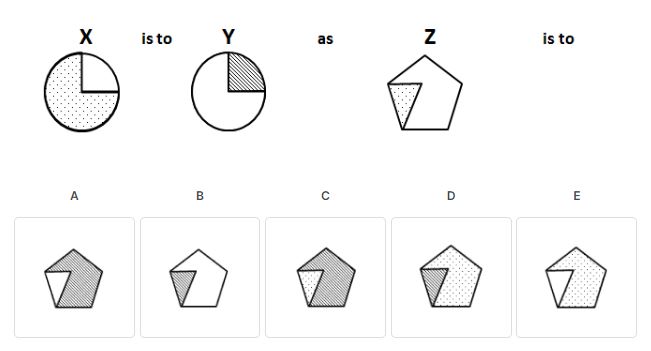
Sample Question 10:
Which option completes the sequence best?
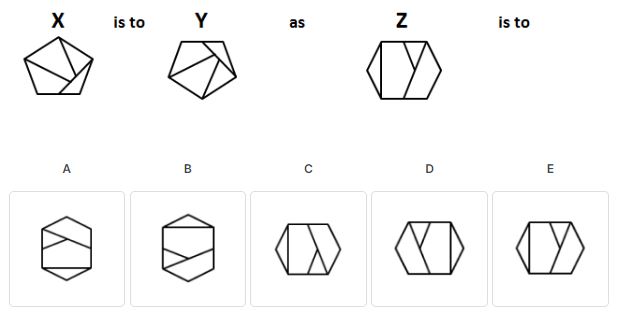
There are two pairs of images presented in this series of questions. There will be one pair that is complete and one pair that is incomplete. There will be differences between the two pairs, despite their similar patterns. It is therefore necessary to identify what is alike in the first set so that it can be organically incorporated into the second set.
This test measures your ability to think laterally and fluidly to determine your ability to recognize patterns, rules, and trends in data. In this test, your future employer will be able to determine your ability to learn new skills, solve problems strategically, and analyse new information. Check out these Abstract Reasoning Analogies questions. Other Abstract Reasoning practice questions are included in Saville, CCAT, and Aon cut-e.
Want to Practice More?
Challenge yourself with more Abstract Reasoning sample questions. Find additional practice questions in Saville, CCAT, and Aon cut-e.
Continue Practicing for the Abstract Reasoning Exam
Access more Abstract Reasoning practice tests and other valuable Abstract Reasoning prep materials so that you take the test while being as prepared as possible:
- Alva Labs Logic Test - Includes 3 Alva Logic test practice simulations and a full Alva Personality Test.
- Matrigma Test Preparation- Learn with 2 Full Abstract Reasoning Matrigma Test Simulations, 8 extra Matrices practice tests, and 11 Inductive reasoning exercises.
- Raven Practice - This prep pack includes 4 Raven's Advanced Progressive Matrices Tests and one full Raven's Standard Progressive Matrices Test.
- UCAT Abstract Reasoning - Includes 11 Abstract Reasoning Tests (340 questions), 2 Full UCAT Cognitive Simulations (318 questions), Verbal Reasoning, Decision-Making, and Quantitative Reasoning questions.
- Hudson Abstract Reasoning Test Prepack offers 3 Full-length Hudson-style Abstract Reasoning practice tests and nine additional Diagrammatic drills.
- EPSO Abstract Reasoning Test Practice - In this prep pack, you'll find 7 EPSO-Style Abstract reasoning tests and 8 extra practice drills and tests.
- Saville Abstract Tests - 4 Timed full Saville Abstract Reasoning Practice Tests 25 Additional Abstract Reasoning Practice Tests.
More Free Practice
We at JobTestPrep find the assessment tests world highly diverse and fascinating. If you are looking to deepen your knowledge in the aptitude tests world, or you want some extra practice before your test, we've got you covered!
Check out these fantastic free practice tests (all are completely free):
Free Aptitude Test | Free Psychometric Test | Free Numerical Reasoning Test | Free Verbal Reasoning Test | Free Cognitive Test | Free Critical Thinking Test | Free Spatial Reasoning Tets | Free Personality Test | Free Inductive Test | Free Mechanical Reasoning Test


